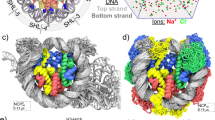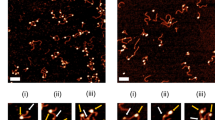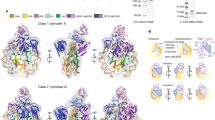Abstract
DNA wrapped in nucleosomes is sterically occluded, creating obstacles for proteins that must bind it. How proteins gain access to DNA buried inside nucleosomes is not known. Here we report measurements of the rates of spontaneous nucleosome conformational changes in which a stretch of DNA transiently unwraps off the histone surface, starting from one end of the nucleosome, and then rewraps. The rates are rapid. Nucleosomal DNA remains fully wrapped for only ∼250 ms before spontaneously unwrapping; unwrapped DNA rewraps within ∼10–50 ms. Spontaneous unwrapping of nucleosomal DNA allows any protein rapid access even to buried stretches of the DNA. Our results explain how remodeling factors can be recruited to particular nucleosomes on a biologically relevant timescale, and they imply that the major impediment to entry of RNA polymerase into a nucleosome is rewrapping of nucleosomal DNA, not unwrapping.
This is a preview of subscription content, access via your institution
Access options
Subscribe to this journal
Receive 12 print issues and online access
$189.00 per year
only $15.75 per issue
Buy this article
- Purchase on Springer Link
- Instant access to full article PDF
Prices may be subject to local taxes which are calculated during checkout





Similar content being viewed by others
References
Richmond, T. & Widom, J. Nucleosome and chromatin structure. In Chromatin Structure and Gene Expression (eds. Eligin, S.C.R. & Workman, J.L.) (Oxford Univ. Press, Oxford, 2000).
Richmond, T.J. & Davey, C.A. The structure of DNA in the nucleosome core. Nature 423, 145–150 (2003).
Kornberg, R.D. & Lorch, Y. Twenty-five years of the nucleosome, fundamental particle of the eukaryote chromosome. Cell 98, 285–294 (1999).
Felsenfeld, G. & Groudine, M. Controlling the double helix. Nature 421, 448–453 (2003).
Felsenfeld, G. Chromatin unfolds. Cell 86, 13–19 (1996).
Khorasanizadeh, S. The nucleosome: from genomic organization to genomic regulation. Cell 116, 259–272 (2004).
Langst, G. & Becker, P.B. Nucleosome remodeling: one mechanism, many phenomena? Biochim. Biophys. Acta 1677, 58–63 (2004).
Muchardt, C. & Yaniv, M. ATP-dependent chromatin remodelling: SWI/SNF and Co. are on the job. J. Mol. Biol. 293, 187–198 (1999).
Narlikar, G.J., Fan, H.Y. & Kingston, R.E. Cooperation between complexes that regulate chromatin structure and transcription. Cell 108, 475–487 (2002).
Peterson, C.L. & Logie, C. Recruitment of chromatin remodeling machines. J. Cell. Biochem. 78, 179–185 (2000).
Polach, K.J. & Widom, J. Mechanism of protein access to specific DNA sequences in chromatin: a dynamic equilibrium model for gene regulation. J. Mol. Biol. 254, 130–149 (1995).
Anderson, J.D. & Widom, J. Sequence and position-dependence of the equilibrium accessibility of nucleosomal DNA target sites. J. Mol. Biol. 296, 979–987 (2000).
Clegg, R.M. Fluorescence resonance energy transfer and nucleic acids. Methods Enzymol. 211, 353–388 (1992).
Li, G. & Widom, J. Nucleosomes facilitate their own invasion. Nat. Struct. Mol. Biol. 11, 763–769 (2004).
Feynman, R.P., Leighton, R.B. & Sands, M. The Feynman Lectures on Physics (Addison-Wesley, Reading, Massachusetts, USA, 1963).
Fan, H.Y., He, X., Kingston, R.E. & Narlikar, G.J. Distinct strategies to make nucleosomal DNA accessible. Mol. Cell 11, 1311–1322 (2003).
Kassabov, S.R., Zhang, B., Persinger, J. & Bartholomew, B. SWI/SNF unwraps, slides, and rewraps the nucleosome. Mol. Cell 11, 391–403 (2003).
Protacio, R.U., Polach, K.J. & Widom, J. Coupled-enzymatic assays for the rate and mechanism of DNA site exposure in a nucleosome. J. Mol. Biol. 274, 708–721 (1997).
Bonnet, G., Krichevsky, O. & Libchaber, A. Kinetics of conformational fluctuations in DNA hairpin-loops. Proc. Natl. Acad. Sci. USA 95, 8602–8606 (1998).
Hess, S.T., Huang, S., Heikal, A.A. & Webb, W.W. Biological and chemical applications of fluorescence correlation spectroscopy: a review. Biochemistry 41, 697–705 (2002).
Krichevsky, O. & Bonnet, G. Fluorescence correlation spectroscopy: the technique and its applications. Rep. Prog. Phys. 65, 251–297 (2002).
Ha, T. et al. Initiation and re-initiation of DNA unwinding by the Escherichia coli Rep helicase. Nature 419, 638–641 (2002).
Halford, S.E. & Marko, J.F. How do site-specific DNA-binding proteins find their targets? Nucleic Acids Res. 32, 3040–3052 (2004).
von Hippel, P.H. & Berg, O.G. Facilitated target location in biological systems. J. Biol. Chem. 264, 675–678 (1989).
Owen-Hughes, T. & Workman, J.L. Remodeling the chromatin structure of a nucleosome array by transcription factor-targeted trans-displacement of histones. EMBO J. 15, 4702–4712 (1996).
Owen-Hughes, T., Utley, R.T., Cote, J., Peterson, C.L. & Workman, J.L. Persistent site-specific remodeling of a nucleosome array by transient action of the SWI/SNF complex. Science 273, 513–516 (1996).
Logie, C. & Peterson, C.L. Catalytic activity of the yeast SWI/SNF complex on reconstituted nucleosome arrays. EMBO J. 16, 6772–6782 (1997).
Beard, D.A. & Schlick, T. Computational modeling predicts the structure and dynamics of chromatin fiber. Structure 9, 105–114 (2001).
Widom, J. Structure, dynamics, and function of chromatin in vitro. Annu. Rev. Biophys. Biomol. Struct. 27, 285–327 (1998).
Widom, J. Chromatin structure: linking structure to function with histone H1. Curr. Biol. 8, R788–R791 (1998).
Widom, J. Toward a unified model of chromatin folding. Annu. Rev. Biophys. Biophys. Chem. 18, 365–395 (1989).
Escher, D. & Schaffner, W. Gene activation at a distance and telomeric silencing are not affected by yeast histone H1. Mol. Gen. Genet. 256, 456–461 (1997).
Patterton, H.G., Landel, C.C., Landsman, D., Peterson, C.L. & Simpson, R.T. The biochemical and phenotypic characterization of Hho1p, the putative linker histone H1 of Saccharomyces cerevisiae. J. Biol. Chem. 273, 7268–7276 (1998).
Freidkin, I. & Katcoff, D.J. Specific distribution of the Saccharomyces cerevisiae linker histone homolog HHO1p in the chromatin. Nucleic Acids Res. 29, 4043–4051 (2001).
Cloutier, T.E. & Widom, J. Spontaneous sharp bending of double-stranded DNA. Mol. Cell 14, 355–362 (2004).
Narlikar, G.J., Phelan, M.L. & Kingston, R.E. Generation and interconversion of multiple distinct nucleosomal states as a mechanism for catalyzing chromatin fluidity. Mol. Cell 8, 1219–1230 (2001).
Shermoen, A.W. & O'Farrell, P.H. Progression of the cell cycle through mitosis leads to abortion of nascent transcripts. Cell 67, 303–310 (1991).
Thastrom, A., Bingham, L.M. & Widom, J. Nucleosomal locations of dominant DNA sequence motifs for histone-DNA interactions and nucleosome positioning. J. Mol. Biol. 338, 695–709 (2004).
Little, J.W. et al. Cleavage of LexA repressor. Methods Enzymol. 244, 266–284 (1994).
Kim, B. & Little, J.W. Dimerization of a specific DNA-binding protein on the DNA. Science 255, 203–206 (1992).
Bernasconi, C.F. (ed.). Investigation of rates and mechanisms of reactions. In Techniques of Chemistry 4th edn. Vol. VI (Wiley, New York, 1986).
Widengren, J. & Mets, U. Conceptual basis of fluorescence correlation spectroscopy and related techniques as tools in bioscience. In Single Molecule Detection in Solution (eds. Zander, C., Enderlein, J. & Keller, R.A.) 69–120 (Wiley-VCH, Berlin, 2002).
Acknowledgements
We are grateful to S. Huang for valuable discussions and comments on the manuscript. We thank J. Little for the LexA expression plasmid, and the Keck Biophysics Facility at Northwestern University for the use of instruments. This work was supported by US National Institutes of Health (NIH) grants GM54692 and GM58617 to J.W., and by NIH grant GM32543, and US Department of Energy grants DE-AC03-76DF00098, GTL2BN Microscopies of Molecular Machines, and SNANOB Design of Autonomous Nanobots to C.B.
Author information
Authors and Affiliations
Corresponding author
Ethics declarations
Competing interests
The authors declare no competing financial interests.
Supplementary information
Supplementary Fig. 1
Stopped-flow FRET as a function of [LexA]. (PDF 257 kb)
Supplementary Fig. 2
Cooperative nonspecific binding by LexA. (PDF 243 kb)
Supplementary Fig. 3
Stopped-flow FRET at elevated [Na+]. (PDF 138 kb)
Supplementary Table 1
Summary of kinetic analyses. (PDF 48 kb)
Rights and permissions
About this article
Cite this article
Li, G., Levitus, M., Bustamante, C. et al. Rapid spontaneous accessibility of nucleosomal DNA. Nat Struct Mol Biol 12, 46–53 (2005). https://doi.org/10.1038/nsmb869
Received:
Accepted:
Published:
Issue Date:
DOI: https://doi.org/10.1038/nsmb869
This article is cited by
-
Histone variant H2A.Z modulates nucleosome dynamics to promote DNA accessibility
Nature Communications (2023)
-
Generating specificity in genome regulation through transcription factor sensitivity to chromatin
Nature Reviews Genetics (2022)
-
“Flexible hinge” dynamics in mismatched DNA revealed by fluorescence correlation spectroscopy
Journal of Biological Physics (2022)
-
Histone dynamics mediate DNA unwrapping and sliding in nucleosomes
Nature Communications (2021)
-
LEAFY is a pioneer transcription factor and licenses cell reprogramming to floral fate
Nature Communications (2021)




